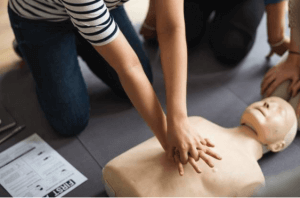
Modern rescue breathing (or mouth-to-mouth resuscitation) was first developed by Peter Safar and James Elam in 1956, and the invention of CPR later followed in 1960. Since that time, rescue breathing, the act of manually inflating the lungs via mouth-to-mouth, breathing pumps or breathing machines, has been a key component of the CPR method. However, recent studies have shown that chest compressions alone are as effective as conventional CPR, as a means to preserve brain function in out of hospital cardiac arrest.
Those studies, in conjunction with the disheartening statistics that show a 90% mortality risk for out-of-hospital cardiac arrest, have led to a public awareness campaign to improve the survival rate. In 2008, the Hands-Only CPR method was introduced to encourage the intervention of untrained by-standers in a cardiac event. With this greater understanding regarding the effectiveness of CPR, you may wonder if rescue breathing still has a place in this emergency procedure. To answer this question, we will take a closer look at the two types of CPR
Hands-Only CPR – The key for this method is that it is geared for the untrained by-stander. The steps for Hands Only CPR are simple and easy to remember: Call 911 and push hard and fast in the center of the chest (100-120 compressions/min). While effective, it is also intended to be a launching point that encourages the public to learn more about CPR. Hands Only CPR will not meet the CPR job requirements and can only be performed on adults and teens.
CPR Training – This conventional form of CPR still utilizes compressions and rescue breaths and will meet work related requirements. Unlike the former, this method can be used on any victim of cardiac arrest, including infants and children. Compressions must still be performed at a rate of 100-120/min with 2 rescue breaths.
In addition to the cases discussed above, there are other emergency events where rescue breaths also must be employed:
- Drowning
- Drug overdose
- Prolonged cardiac arrest victims
- Breathing troubles that cause collapse
If you have received certified CPR training, you should continue to utilize rescue breaths when administering CPR. However, if you have not yet taken the step to learn conventional CPR, familiarize yourself with the Hands-Only procedure and contact us to learn more about becoming CPR certified!